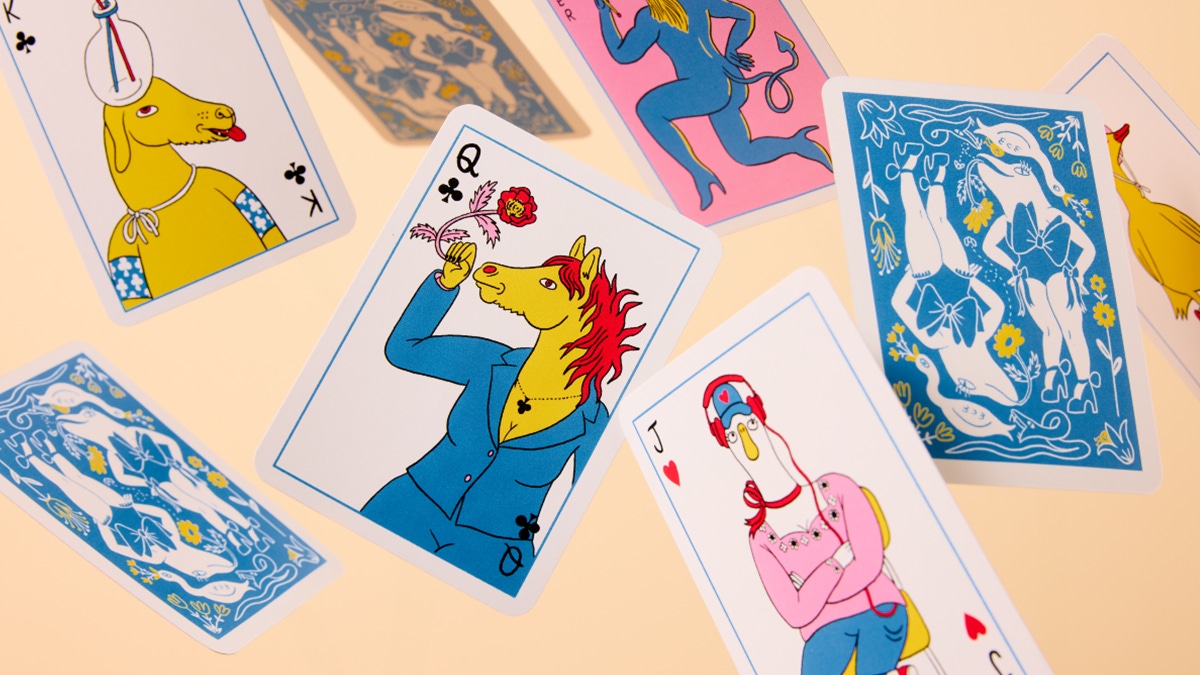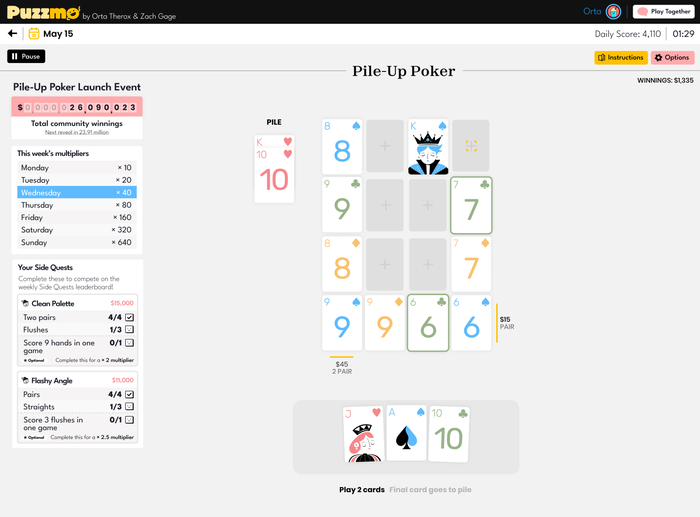Trending
Opinion: How will Project 2025 impact game developers?
The Heritage Foundation's manifesto for the possible next administration could do great harm to many, including large portions of the game development community.
Designer Zach Gage breaks down the lifecycle of his latest card-based brainteaser.

A few weeks ago we received a mysterious Joker card in the mail. It had travelled all the way from New York to drizzly Manchester with a message: Zach Gage and the Puzzmo team are ready to share their latest creation. The ace in the hole? Pile-up Poker. A fresh twist on the centuries old card game designed for those who love the bite-sized newspaper games Puzzmo has been offering daily since launching last year.
Last time we spoke, Gage shared his vision for a space that could provide a home for a myriad of playful conundrums and its player community. So far, Puzzmo seems to be making good on that promise. The platform has over 600,000 monthly active players. Two-thirds of revenue is generated by subscribers (who get access to more games, features, and perks), while the rest comes from advertising. Crucially, the average number of games played per day is growing by 20 percent month-over-month. But which experiences are people flocking towards?
Puzzmo launched with a range of titles including Cross|Word, Really Bad Chess, and SpellTower. More soon followed. Flipart, Cube Clear, Wordbind joined the family, and now Pile-Up Poker has taken center state. We're told Pile-Up Poker actually tested well enough during development to warrant a fast-track wide-release, instead of the usual three-month subscriber-only early access period. Clearly, it had that special something, and since dropping on June 3 it has become the most played title on a daily basis.
On paper it's a cut-and-dry success story that might as well have been scripted, so we were surprised to hear Pile-Up Poker was actually cancelled mid-development before swiftly being pulled back from the brink.
"I want people to be able to show up and just click around and find their way" Gage tells us, explaining how Pile-Up Poker was intended to be a more freeform experience that encourages instinctive experimentation.
On a visual level it does that almost immediately, presenting players with a four-by-four grid that must be filled with cards to create poker hands (running horizontally or vertically). There are multiple turns (draws) to an individual game, and each one requires players to place four cards before the fifth is discarded. There's depth, too. Eventually you realize the discard pile can be used to make another hand, as can each of the grid's four corners. Oh, and more hands means more multipliers. Lovely, score-boosting multipliers.
"One part of [encouraging that experimentation], which we changed with Pile-up Poker, is that instead of having big instructions pop-up you have a little goal at the top of the page that's very vague and doesn't tell you how the game works. That's a big change for us, because I feel like with instruction pop-ups, people just close them. So you're not actually getting any information across, and then the game has to do all the work carrying the tutorialization," explains Gage.
"So what we're trying now is an approach where our games are very sandboxy and you can learn them just by clicking around." In its current guise, then, Pile-Up Poker feels like a strangely familiar blank canvas that demands wistful exploration—even if you have no prior knowledge of poker. Gage feels it has an "approachable fun-ness" that doesn't encourage players to find an optimal way to win. That latter is particularly important when trying to appease Puzzmo's scoreboard chasers. As can happen sometimes during game development, the earliest version was the exact opposite.
Gage says the first incarnation featured a five-by-five grid and was inspired by video poker. Discarded cards played a bigger role, and when shunned by players would have been transported somewhere else within the play space. "You weren't actually throwing anything out," Gage adds. "That version was very constrained where every decision had a knock-on effect. Instead of having cards in a hand, those cards were on a board. You could move some of them to a higher row, and then your cards would collapse down and new cards would come in–but you could move less of those. You were sort of building up the board, and your discards were building down the board.

Gage says a 'v3' prototype is where things 'get a little wild and/or unhinged'
"I think, at the time–because I'm designing games for myself I tend to build games that replicate the experience I'm having–and at the time I'd been working to close the [Puzzmo] deal and it was this very intricate process. Then as soon as that happened I had to learn how to be a person that's a good leader of a small group of people. I'd never done that before. My life was a thousand things that I was trying to learn in a million ways [...] and that's kind of what the game ended up feeling like."
In short: that version of Pile-up Poker was complicated. But Gage says it was complicated in a way that actually discouraged people from playing it. There were too many permutations to consider. Too much cause and effect. Depth isn't a bad thing, but this incarnation was threatening to drown players.
Those frustrations eventually boiled over and culminated in a phone call with Puzzmo owner Hearst. Gage told them he'd decided to cancel Pile-up Poker because it wasn't an experience he wanted on the website. It was, he felt, too intense and completely at odds with the sort of project they needed to roll out. "I was like 'we can't do this game,'" says Gage. "We needed a new plan."
Still downbeat about the cancellation, Gage shared the news with his colleagues at an event that was happening the next day. The entire team was in town and many of them still wanted to take it for a spin. With nothing to lose, Gage obliged and was quickly peppered with feedback.
"One thing that's funny about making games is that when you make a good game, there's always like a thousand terrible games sitting next door," he says. "And when you make a bad game, there's usually a good game right next door. But sometimes it's impossible to see it."
Gage admits he finds it easier to see the thing that's very far away, then the answer that's right next to him. "I really tried [to see it], but I couldn't do it. Then [our crossword editor] Brooke Husic sat down and was like 'what if it was three cards? And what if you could play them anywhere?' Then it very quickly fell into this zone which is basically the game you see today. I spent a little more time with it and added the discard hand, and that became the game."
Previously, Gage has admitted he makes games for himself. He's had plenty of success with that technique, but this time it just didn't click. In opening the project and his own process up to outside forces, he found perspective. It helped pull Pile-up Poker back from the brink, and for Gage it was a pivotal moment. "I was so ready to accept a radical shift in what the game could be, because I'd just cancelled it. And also because a lot of the things Brooke was saying were the things [game designer] Jack Schlesinger had been trying to get me to hear the whole time. So it was an interesting team-building experience in a good way, and to me it connected to the experiences that I've been having in trying to do a good job [as a team leader]."

When asked whether the experience means he's now more open to collaborating a little earlier, Gage suggests that's absolutely possible–but he still feels its important to start creating with a coherent vision. "It's tough because there's a tension in game design. All design projects, but especially games, are about the story you're telling. You're setting up the answers to the questions you're giving people at the start, and sometimes that means the right thing later isn't the right thing at the start–because the rest of the story hasn't changed," he explains.
"When you're operating as a lead on a game you have to make sure the story is coherent. You have to balance that with also hearing feedback from everyone on the team and being able to open up the design to other options. That is a very challenging process, and even more challenging when you have more than one person who you're working with. I've definitely learned some lessons, but I also think this is a [challenge] that's natural to games. The best way to do it is to start in a situation where everyone who's inputting [ideas] sees the story the same, but has different ideas."
For Gage, progressive collaboration is about preserving those formative design beats without stunting growth. He explains the idea of corner scoring in Pile-up Poker replaced diagonal scoring simply because it was more fun. The multipliers were added for the same reason. Despite those transformative tweaks, the final version still feels like the game Gage originally wanted to make, which was in its purest form was a puzzler where you discard cards. The trappings might be fundamentally different, but crucially for Gage, its soul remains unchanged.
Read more about:
Top StoriesYou May Also Like